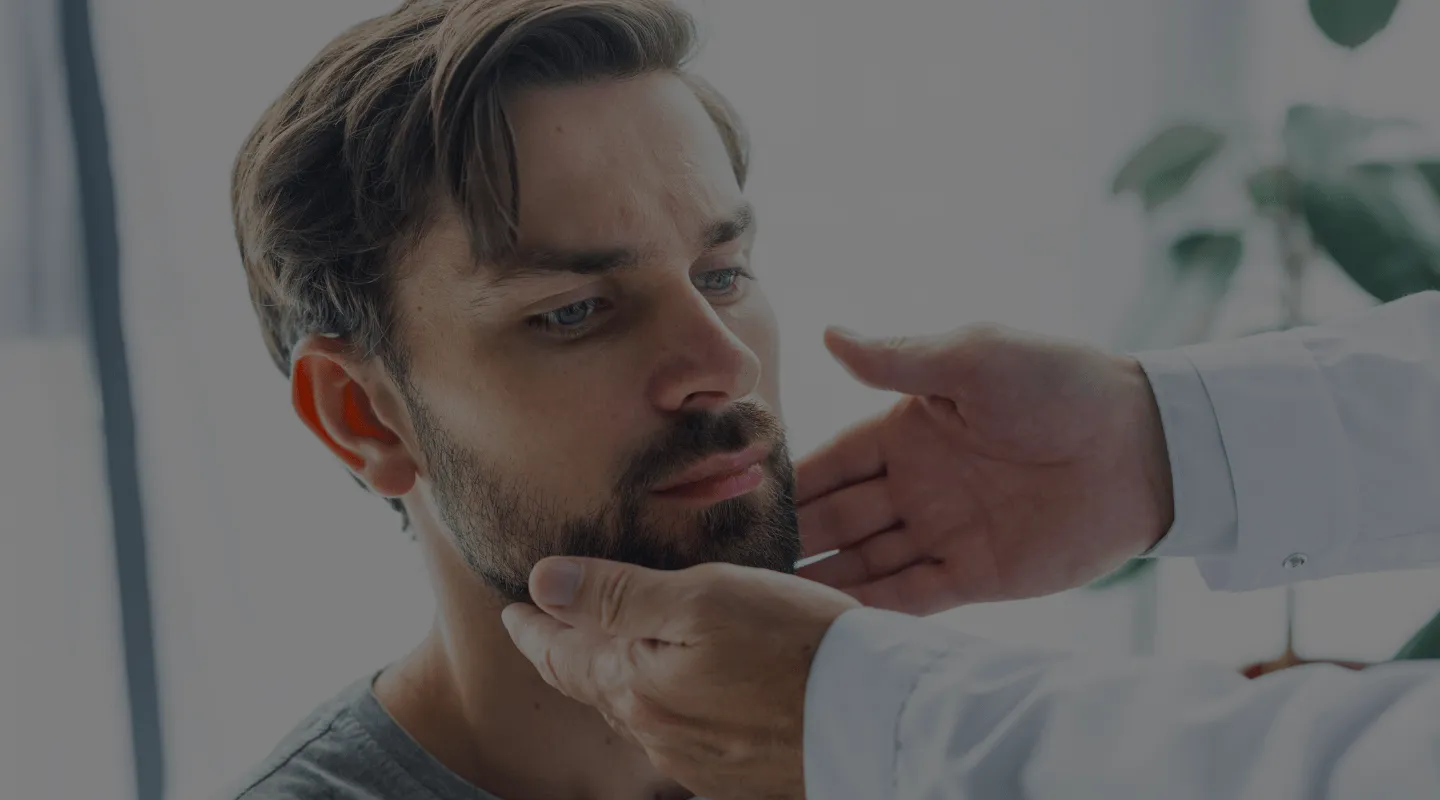
Beard Transplant
Your Affordable Beard Transplant in Tunisia
Restore density, shape, and character to your beard with a 100% natural technique
How does it work?
What is beard transplantation?
Beard transplantation, also known as beard grafting, beard implant, or beard hair transplant, is a cosmetic procedure that allows men to restore or thicken their beard and mustache. This advanced surgical intervention involves transplanting hair follicles from the patient’s donor area to the sparse or thinly populated areas of the beard. Thanks to the precise implantation of these follicles, beard grafting offers natural and lasting results. This allows men to sculpt their beard according to their aesthetic preferences. Beard grafting offers a promising solution to:
- fill in sparse areas,
- correct irregularities
- create a full beard where it was absent.
How does a beard transplant work?
Beard transplantation is an effective solution for those who want to grow a dense and thick beard. Indeed, it is the ideal solution in case of a thin beard, sparse areas or beard alopecia. The procedure involves integrating beard and mustache hairs taken from the patient’s donor area. In general, the donor area is located at the back of the head. These hair follicles are then precisely implanted in the targeted areas of the beard. Note that this procedure stimulates hair growth. Over time, the transplanted hairs continue to grow normally. This is why the graft gives the beard a full and neat appearance. Thanks to this advanced technique, it is now possible for men who are beardless or with a poorly developed beard to benefit from a fuller beard and enjoy a masculine and elegant look.
Who is the beard transplant procedure for?
The beard transplant procedure is mainly for men who want to increase the density of their facial hair for aesthetic or reconstructive reasons. This includes those who have a naturally sparse or uneven beard, as well as those who have suffered trauma, burns, or illnesses that have resulted in hair loss on the face. In addition, some men may seek this procedure to correct scars or skin imperfections. In short, beard grafting is a suitable solution for anyone who wants to obtain a fuller and more uniform beard, thus meeting personal aspirations of style and self-esteem.
What are the eligibility criteria for a beard transplant?
Several criteria must be considered to be eligible for a beard transplant. First, beard densification is one of the main objectives of beard transplantation. If you have a sparse beard or bare patches, you may be a candidate for this procedure. The most commonly used technique for beard transplantation is FUE (Follicular Unit Extraction). Indeed, this technique allows the beard hairs to be harvested and implanted precisely. You must have a sufficient amount of beard hairs available in the donor area to ensure adequate coverage of the areas to be treated.
The surgeon will assess the quality of the beard hairs, their thickness and texture, to ensure satisfactory results. Finally, you must be in good general health and not have any medical conditions that could compromise the healing process. By considering these criteria, you can determine if you are a good candidate for a beard hair transplant.
What is the FUE beard implant technique?
The FUE (Follicular Unit Extraction) technique is increasingly used for beard grafting. First, the donor and/or recipient area is shaved. Then, the follicular units are extracted one by one from the donor area, which is often the back of the skull. This is when the extracted grafts are processed and selected. The surgeon then proceeds with the grafting by making micro-incisions on the recipient area of the beard. Depending on the desired beard density and the number of grafts processed, the beard transplant can last 4 to 8 hours. It is performed under local anesthesia and on an outpatient basis.
What is the price of a beard transplant in Tunisia?
More and more Tunisian and foreign patients are opting for a beard transplant in Tunisia. The price of a beard transplant in Tunisia remains very affordable compared to those practiced in Europe. In parallel, the conditions of the intervention are comparable to those of European clinics. Many people ask themselves how much does a beard transplant cost in Tunisia? Does a beard transplant cost more than a hair transplant? The answer is normally yes, but it will depend on the number of grafts to be treated.
Your health, our priority.
Request your free quote.
What are the common reasons why men choose a beard transplant?
There are several common reasons why men opt for a beard transplant. Some people may have limited facial hair or no beard at all on their cheeks. This characteristic can make them appear younger or less masculine. Thanks to beard grafting, it is possible to fill in these areas devoid of hair by implanting beard follicles from the donor area. This stimulates hair growth and allows the beard to grow naturally on the cheeks.
For those who want a thick and well-furnished beard, beard grafting offers a reliable and lasting solution. Whether to strengthen facial hair, fill in sparse areas or create a full beard, this procedure allows men to graft facial hair that meets their aesthetic expectations and to have a more mature and virile look.
How do you know if a beard implant is successful?
Regardless of the type of procedure performed, within 3 or 4 months, the transplanted hair follicles should be in place and growing.
You will know that the beard implant has been successful if, at 8 or 9 months, you have a full, healthy beard that you can treat as if it had been there from the beginning. While FUE and FUT can produce natural-looking beards, FUT beards tend to be fuller. Indeed, more follicles are generally harvested when a strip of skin is removed. So, if your goal is a thicker beard, consider FUT. Failure of beard grafting is rare and is usually the result of poor harvesting in the donor area. This is why it is important and worthwhile to pay more to choose an experienced hair restoration surgeon.
How long does the beard transplant procedure in Tunisia take?
The duration of the beard transplant procedure can vary depending on several factors. First, the beard transplant surgeon will perform an initial assessment. At this stage, they determine the desired beard density and the amount of hair follicles needed. The FUE (Follicular Unit Extraction) technique is often used to harvest the follicles individually. However, this technique can take time depending on the donor area and the number of grafts required.
Male facial hair cosmetic surgery can take several hours, generally between 4 and 8 hours, depending on the extent of the graft and the complexity of the procedure. The procedure is performed under local anesthesia to ensure patient comfort. Although the duration may seem long, it is important to note that precision and attention to each graft are essential to obtain natural and satisfactory results. The beard transplant surgeon will ensure that the procedure is performed safely and efficiently, taking into account the desired beard density and providing post-operative instructions for optimal healing.
What postoperative care is needed after a beard transplant?
At the end of the beard transplant, a dressing is applied to the donor area. Facial edema may form after 1 or 2 days and then resolve a few days later. Scabs will form on the harvesting and recipient areas and will disappear after a week. The skin will be red in the beard area before returning to its normal color after a few days. Be careful not to rub the grafts during the first week and to protect them from any pulling and tearing.
As with FUE and hair transplantation, a “shedding” phenomenon, i.e. a loss of the implanted hair shaft, occurs in the first three months. Subsequently, the grafts will grow and become denser over the months. The beard transplant may have an irregular feel due to the healing of the implants. After 10 to 12 months, the skin will become smooth again. A few months after the beard transplant, the face is covered with natural hair thanks to the 1000 to 2000 grafts transplanted from the head to the patient’s jaw.
Gray beard transplant, is there a solution?
Some men who are starting to have gray or white hair, and also a gray or white beard, wonder if they can regain the color of their beard from when they were 18 with a beard transplant. The answer is mixed. If the grafts to be transplanted are taken from the back of the skull and are not yet white or gray, there is a possibility of temporarily regaining the hair color of the past. But if the genes tend to favor the white color of the beard, there is nothing to be done.
What to do to avoid a failed beard transplant?
To avoid a failed beard transplant, it is essential to take several precautions before and after the procedure. First, choosing a qualified and experienced surgeon is crucial; make sure to check their certifications, track record, and previous patient reviews. Before the procedure, carefully follow the surgeon’s pre-operative recommendations, such as stopping certain medications or supplements that could affect healing. After the transplant, strictly follow postoperative care, including avoiding touching or scratching the treated area and using the prescribed products to promote healing. In addition, it is important to protect the grafted area from the sun and not to engage in strenuous physical activities that could compromise the grafts. By taking these precautions, you maximize the chances of obtaining a successful and satisfactory result.
Recovery Time
Recovery time after a beard transplant is generally short, but varies from person to person. Immediately after the procedure, it is common to experience mild swelling and redness around the treated areas. These symptoms usually subside within a few days. Scabs formed on the grafts generally fall off in one to two weeks. Avoid strenuous physical activity and direct sun exposure during this period to promote good healing. Most patients can resume normal activities, including work, within a few days. However, for optimal results, it is recommended to carefully follow the postoperative instructions provided by the surgeon.
Can I have a beard transplant and a hair transplant in Tunisia at the same time?
Some men decide to take advantage of their hair transplant intervention to also have a beard transplant. If the number of grafts is sufficient to achieve good density in the areas to be covered, both on the head and on the face, and depending on the patient’s priority between hair and beard, it is possible to combine the two interventions at the same time. If, on the other hand, the patient seeks to significantly densify both the head and face, two separate interventions spaced 12 months apart would probably be necessary.
What are the risks?
Beard transplantation is a hair surgery that is increasingly mastered in Tunisia and elsewhere in the world. As with any intervention, there are risks of failure, such as an unsatisfactory or asymmetrical result due to poor graft harvesting or poor hair transplantation. Beard transplantation can cause a skin infection that can be treated with antibiotics or epidermoid cysts that will disappear with simple treatment. Also, micro-scars can form on the face. Finally, 2 to 3 weeks after the beard transplant, hair loss will be observed.
Can I combine a beard transplant with another procedure?
Beard grafting is an outpatient procedure and recovery is relatively smooth. Some patients take advantage of their stay in Tunisia and opt for dental care such as dental veneers, in-office whitening, but also a complete check-up. Feel free to contact us if you have any additional care requests.
What is the usual result of a beard transplant after a few months?
After a growth and shedding cycle, the final result starts to appear after 6 months of the beard transplant. After 12 months of the transplant, the final result is obtained. Thus, the patient regains a natural look of dense and regular beard. The results of beard grafting, minoxidil beard before and after, are often spectacular.
Success Rate of Beard Transplant in Tunisia
The success rate of beard transplantation is remarkably high, reaching approximately 95%. This percentage indicates that the vast majority of patients undergoing this procedure obtain satisfactory results. Indeed, they obtain a density and growth of the beard that meets their expectations. This high success rate is attributable to technological advances and the sophisticated techniques used by surgeons specializing in hair transplantation. In addition, good pre-operative preparation and appropriate post-operative care also help to optimize results. Thus, men seeking to improve their facial hair can consider this intervention.
Our advantages


Frequently Asked Questions
An expert beard grafting surgeon must have specialized training in plastic or dermatological surgery, as well as a background in hair grafting. Ideally, they should have performed several hundred beard grafting procedures with documented results and participated in continuing education on the latest grafting techniques.
The FUE (Follicular Unit Extraction) technique involves individually extracting hair follicles from the donor area, while the FUT (Follicular Unit Transplantation) technique involves harvesting a strip of skin containing follicles. FUE is less invasive, leaves less visible scarring, and allows for faster recovery, while FUT is indicated in grafts requiring a larger number of follicles.
Yes, beard grafts can be used to cover facial scars. However, the success of the graft depends on the quality of the scar and the blood supply to the area. A consultation with an experienced surgeon is necessary to determine feasibility and develop a personalized treatment plan.
The surgeon determines the density of beard grafts based on the patient’s natural hair density, their aesthetic expectations, and the graft area. An experienced surgeon assesses these factors to create a natural and harmonious appearance, taking into account the natural density of the facial hair and the capacity of the donor area.
Generally, preoperative preparation involves a detailed consultation, blood tests, and specific instructions to stop certain medications or supplements. In addition, the patient should avoid alcohol and tobacco, and follow the surgeon’s specific recommendations for preparing the skin and hair follicles.
Signs of infection after a beard transplant may include redness, increased swelling, pain, and pus at the graft site. If an infection is suspected, consult the surgeon immediately for appropriate treatment, which may include oral or topical antibiotics.
Yes, it is possible to use hairs from other parts of the body, such as the chest or legs, for a beard transplant. However, the characteristics of the hairs may vary in terms of texture and growth cycle, and the surgeon must assess compatibility to obtain a natural result.
The survival rate of hair grafts can vary, but with modern techniques and good postoperative care, it can reach 90 to 95%. Factors such as the grafting technique, the surgeon’s experience, and postoperative care influence this rate.
The grafted beard follows the natural growth cycle of the hairs. In this sense, after the initial shedding phase, the hairs begin to regrow and continue to grow permanently. In addition, over time, grafted hairs may require maintenance similar to natural hairs, such as trimming and beard care.
For dissatisfied patients, touch-ups or corrective procedures can be considered. Discuss concerns with the surgeon to consider correction possibilities. Options may include additional grafts, growth stimulation treatments, and camouflage techniques.
